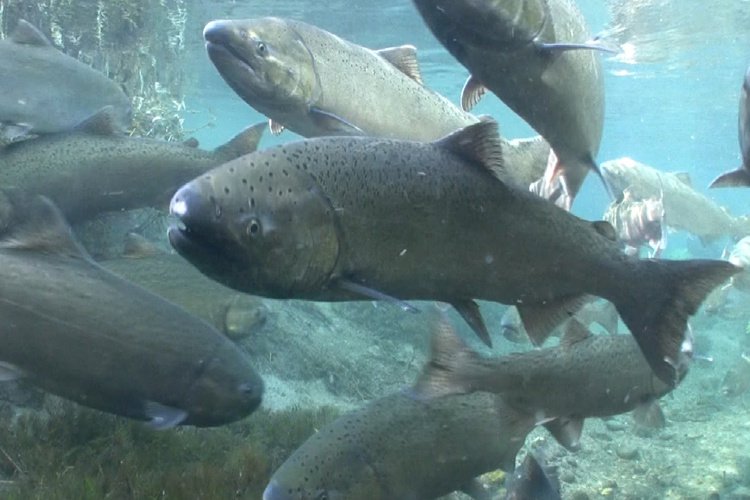2020 Columbia River Salmon And Steelhead Forecast: Low, Again
- April 17, 2020
- John Harrison

Salmon and steelhead returns to the Columbia River this year likely will be below the recent 10-year average, again, the Idaho, Oregon, and Washington fish and wildlife agencies reported to the Council at its April meeting (Idaho report on Snake River forecasts here). One bright spot, though, is sockeye, which return in three components – two to the upper Columbia and one to the Snake River in Idaho. The 2020 sockeye run is predicted to be about three times as large as the 2019 run.
Bill Tweit, Special Assistant to the Director of the Washington Department of Fish and Wildlife, told the Council not expect a good return in 2020.
“We expect the return to be very poor,” he said at the Council’s April meeting.
Tweit said one possible cause of the lower-than-average returns in recent years is poor salmon and steelhead survival in the ocean. Research indicates that first-year survival in the ocean is critically important to survival, and that second-year survival is nearly as important. During the first two years in the ocean, juvenile salmon and steelhead must have an adequate food supply and avoid predators. In recent years ocean feeding conditions have not been ideal, and the extent of predation, while well understood in the Columbia and Snake rivers, is poorly understood in the ocean.
Overall, the states predict a total 2020 return to the mouth of the river of about 1.2 million fish, a slight increase from 940,000 fish in 2019. The bright spot in 2020, the sockeye forecast, is for about 246,300 fish, compared to about 63,222 last year. The 2020 forecast includes about 1,300 Snake River hatchery sockeye (plus 114 natural-origin fish), an ESA-listed endangered species, which is about twice the 10-year average. Wild steelhead returns are expected to be very low in both the Columbia and Snake rivers.
Otherwise, all of the Columbia and Snake river runs with the exception of upriver summer steelhead and fall Chinook are predicted to return in numbers similar to or lower than last year. Here are the forecasts:
- Fall Chinook, 438,300, an increase over the 2019 return of 375,800. Of these, the prediction for upriver bright Fall Chinook, which spawn primarily in the Hanford Reach, is 233,400, compared to 200,000 in 2019, and the number of tule fall Chinook, which primarily return to hatcheries in the lower Columbia region, is predicted to be roughly the same as last year -- 51,000 fish compared to 50,000 in 2019.
- Spring Chinook, 81,700, compared to the 2019 run of 73,101. The upper Columbia part of the run, an ESA-listed threatened species, is predicted to number 13,600 (2,300 wild). The 2019 run was 14,651 fish (1,668 wild).
- Coho, 144,800, compared to 210,885 in 2019.
- Upper Columbia summer Chinook, 38,300 fish; the 2019 return was 34,619.
- Upriver summer steelhead, 199,700 fish, an increase over the 2019 return of 151,201.
- Wild winter steelhead, an ESA-listed threatened species, 10,100 fish compared to 9,000 in 2019.
For the Snake River, Christine Kozfkay of the Idaho Department of Fish and Game, provided these forecasts, by species:
- Natural-origin Spring/Summer Chinook: 7,065 fish, compared to the 2019 return of 4,152 (10-year average 16,031)
- Hatchery Spring/Summer Chinook, 30,069, compared to the 2019 return of 19,529 (10-year average 55,798)
- Natural-origin Fall Chinook, 6,590, compared to the 2019 return of 6,558 (10-year average 10,893)
- Hatchery Fall Chinook, 11,560, compared to the 2019 return of 9,950 (10-year average 27,277)
- Natural -origin Summer Steelhead, 17,630, compared to the 2019/20 return of 9,014 (10-year average 25,539). The A run forecast is 16,650; the B Run forecast is 980.
- Hatchery-origin Summer Steelhead, 32,040, compared to the 2019/20 return of 23,182 (10-year average, 91,225); A Run: 26,300, B Run: 5,740.
- Natural-origin sockeye, 114 compared to the 2019 return of 41 (10-year average 186)
- Hatchery-origin sockeye, 1,327 compared to the 2019 return of 9 (10-year average, 764).



